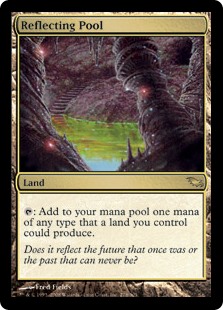|
Michael "Maikeruu" Pierno |
Today's cards of the day are the slow dual
lands from Tempest which only do anything every
other turn. The primary benefit these have
over the more frequently seen enters play tapped
lands is that these can tap for mana the turn
they enter play, but otherwise they are somewhat
weak compared to other options. They can
support a turn one only deck and being able to
tap for colorless allows them to work well in a
build with minimal color requirements.
Overall these are middle of the road for dual
lands and can still see play in certain designs.
Constructed: 2.5
Casual: 2.5
Limited: 3.5
Multiplayer: 2.5
|

David Fanany
Player since
1995 |
Tempest Slow Lands
Tempest actually had two cycles of dual lands:
this cycle, printed as uncommons, and a cycle of
enemy-colored dual lands that came into play
tapped and also dealt damage when tapped for
colored mana, printed as rares. This was the
first set with ten dual lands since Revised,
although each cycle was less powerful than both
the original dual lands and the Ice Age painlands. As a matter of fact, Tempest
also had Reflecting Pool, which saw more
tournament play at the time due to its speed and
its interaction with Gemstone Mine and
Undiscovered Paradise. These lands are still of
interest as examples of a certain design
philosophy - the concept that if you really need
a specific color of mana, you will do whatever
is necessary to get it - and I find it hard to
argue that any land that taps for two colors of
mana is inherently bad.
Ice Age painlands. As a matter of fact, Tempest
also had Reflecting Pool, which saw more
tournament play at the time due to its speed and
its interaction with Gemstone Mine and
Undiscovered Paradise. These lands are still of
interest as examples of a certain design
philosophy - the concept that if you really need
a specific color of mana, you will do whatever
is necessary to get it - and I find it hard to
argue that any land that taps for two colors of
mana is inherently bad.
I believe that Tempest's slow lands were
intended to be an iteration of yesterday's
lands, minus the use of counters and the
requirement of keeping track of upkeep triggers.
In later sets, using counters of different types
stopped being seen as a drawback, and I can't
help but wonder if Wizards of the Coast would
have kept using depletion counters and the like
if designs like Power Conduit and Chisei, Heart
of Oceans had occurred to them earlier.
Constructed: 2/5
Casual: 2/5
Limited: 3/5
Multiplayer: 3/5
EDH/Commander: 2/5
|


